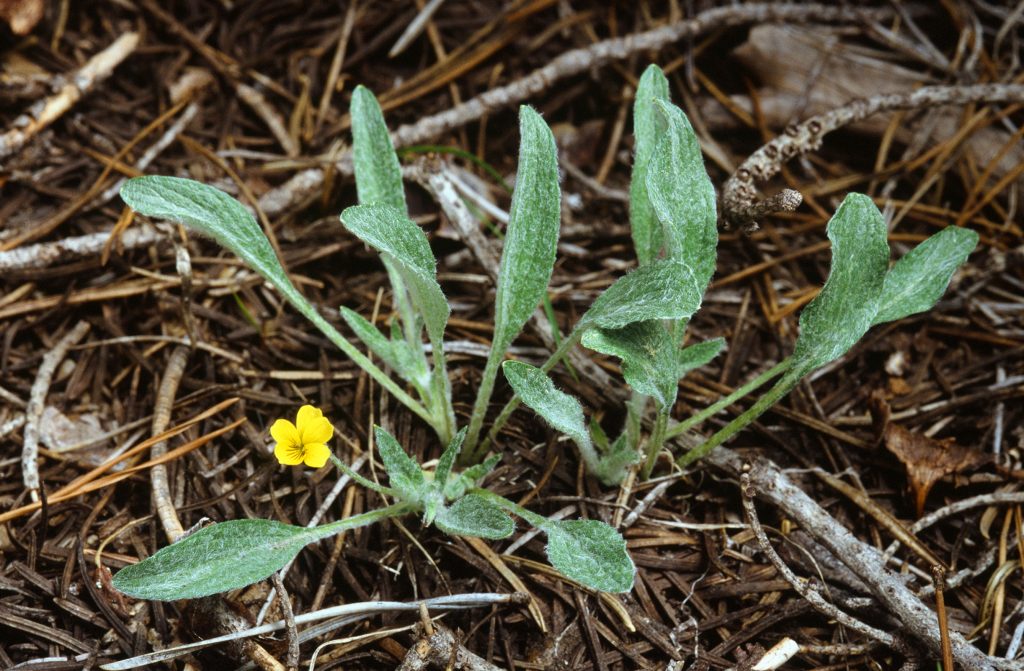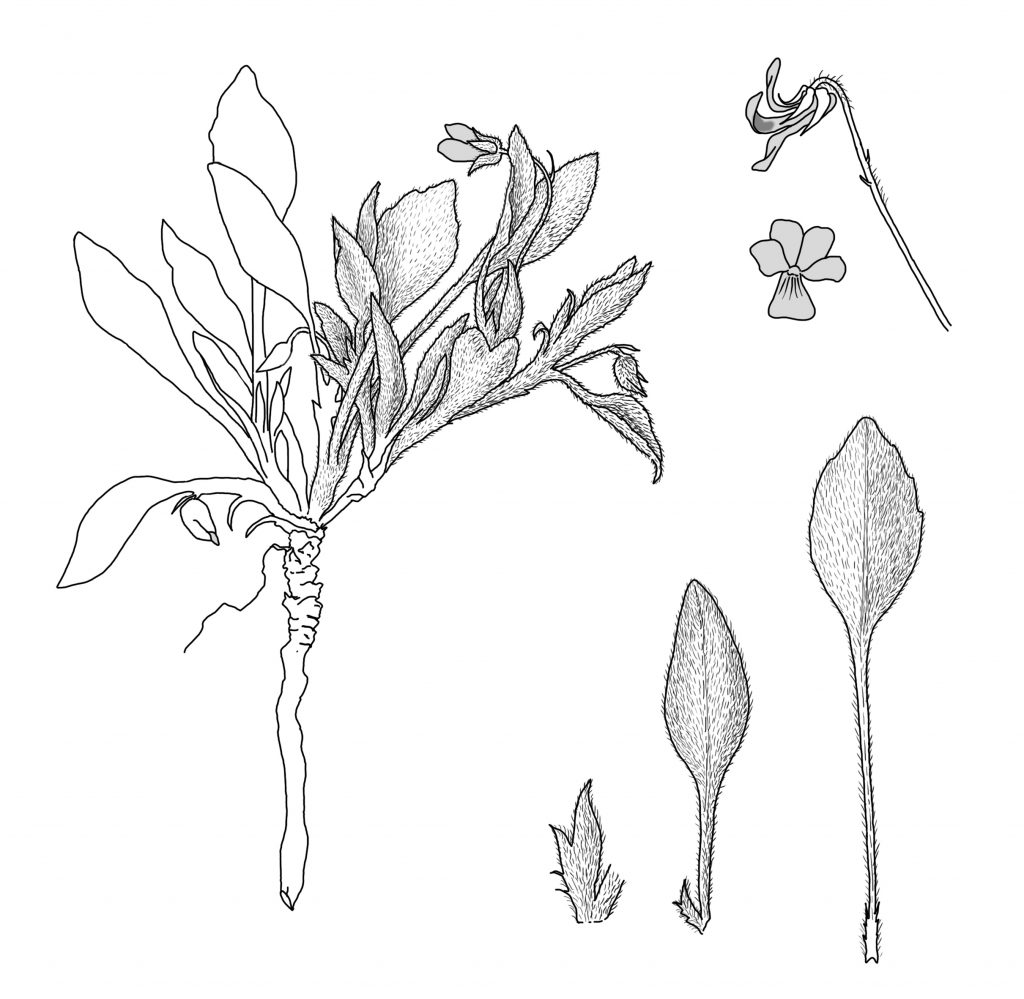Viola tomentosa
Kim’s unedited notes (key). Illustrations: 2 photographs of Viola tomentosa and 1 drawing
Baker, M.S. & Clausen, J.C., Leafl. W. Bot. 5:142. 1949
Two collection dates of Isosyntypes in DS: 9 Jul 1937 and 5 Aug 1937; also several isosyntypes in CAS but undated.
2N=12, IPCN 86-87, Fabijan, D.M., Packer J.G., & Denford, K.E., 1987.
See Abrams L. R. & R.S. Ferris. An Illustrated Flora of the Pacific States: Geraniaceae to Scropulariaceae, Vol. 3. 1951. Stanford University Press.
Eldorado National Forest, CA, mainly on granitic soils. Fl. June to August, depending on year and elevation.

Jepson on-line: V. tomentosa M.S. Baker & J.C. Clausen
WOOLLY VIOLET
Plant 5–10 cm, white-tomentose
Stem ascending or erect from shallow or deep, woody taproot
Leaves simple, generally elliptic to narrowly ovate; basal petiole 10–60 mm, blade 15–50 mm, (sub)entire; cauline blade 20–40 mm, generally entire
Inflorescence: peduncle 10–40 mm
Flower: petals yellow, lowest (including spur) 6–9 mm, veined dark brown, lateral 2 sometimes with short, dark brown veins near base, short-bearded, upper 2 purple or brown outside
Fruit < 5 mm, hairy
Chromosomes: n=6
Ecology: Dry, gravelly places
Elevation: 1500–2000 m.
Bioregional distribution: north-central High Sierra Nevada.
Cleistogamous flowers 0.

Mike Taylor. June 2, 1998. Growing at 5000 ft [c.1500 m, check this conversion-I read this from the Topo Map but it was not exactly on a line] to north of road from Placerville to Lake Tahoe, with Vv. tomentosa and adunca in sandy soil which had recently been cleared. White Fir (Abies concolor), Lodgepole Pine (Pinus contorta) and Jeffrey’s pine (Pinus jeffreyi). Growing on a SE facing hillside, in a drainage area, damper than V. tomentosa which was growing nearby. Also with Viola adunca. . El Dorado County, 4.6 A-B De Lorme Map of N. California. My notes said metamorphic rocks. On granite. The bedrock is granite, part of the great Sierra Nevada batholith. Granites generally weather into friendly landscapes that invite wandering among the rounded outcrops and the trees. Close examination of the rock reveals its coarsely-crystalline texture composed of rectangular grains of milky-white or salmon-pink feldspar set among glassy grains of quartz, usually irregular in form. Glass-black crystals, flakes of biotite mica or stubby needles of hornblende pepper most granites.
Sierra Wildflowers Mt. Lassen to Kern Canyon, Theodore F. Niehaus, 1974, University of California Press:
Entire plant covered by grey wooly hairs; fls yellow with purple markings on backs. Dry rocky places, 5000-6500 feet, northern Sierra, Mixed coniferous forest, Pinon-Juniper woodland.
KEY TO THE FAMILY VIOLACEAE (VIOLET)
1a. Flowers with some yellow, dry habitat ………………………………………………………. 2
1b. Flowers without any yellow, moist habitat …………………………………………………. 7
2a. Leaf blade divided, cut or lobed ………………………………………………………………… 3
2b. Leaf blade not cut or lobed ……………………………………………………………………….. 4
3a. Lf divided, 3-9 finger-like lobes……………………………………………………….V. lobata
3b. Lf divided into three large lobes which are further sub-divided………..V. sheltonii
4a. Plants white, wooly ………………………………………………………………….V. tomentosa
4b. Plants not white, wooly ……………………………………………………………………………. 5
5a. Flowers deep yellow, leaves heart-shaped………………………………………V. glabella
5b. Flowers pale yellow, lvs longer than wide ………………………………………………….. 6
6a. Leaves oblong, ovary hairless………………………………………………………… V. bakeri
6b. Leaves ovate, ovary hairy …………………………………………………………. V. purpurea
7a. Flowers white ……………………………………………………………………… V. macloskeyi
7b. Flowers blue-violet …………………………………………………………………….. V. adunca

Listed as a threatened species in Endangered and Threatened Plants of the United States, 1978. Edward S. Ayensu, Robert A. de Filipps et al. Smithsonian. Washington, DC.
Smithsonian herbarium has type specimen:
Viola tomentosa Baker, M.S. & Clausen, J.C., Leafl. W. Bot. 5:142. 1949 – Isotype (Violaceae)
COLLECTION: Baker, M.S. with Smith, H., s.n., 09 Jul 1937. USA. California. Nevada. Road to Excelsion Point, slightly W of Hwy. 20, 8.6 mi NW of junction of highways 20 & 40. 1524 m.
VERIFICATION: Specimen compared to secondary resources.
US SHEET NO.: 02179647 BAR CODE: 00114623
TM, 10 July 07:
Two of the taxa that are supposed to be diploid (V. tomentosa, V.douglasii) have more gene copies than they should and they are either diploid heterozygous or tetraploid, so I could not read their sequences; I will have to clone them.